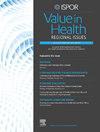疟疾流行地区镰状细胞性贫血儿童的健康相关生活质量:疾病状态和疟疾预防策略的影响
IF 1.4
Q3 HEALTH CARE SCIENCES & SERVICES
引用次数: 0
摘要
目的评估乌干达和马拉维镰状细胞性贫血(SCA)儿童在疾病稳定状态和疾病发作期间的健康相关生活质量(HRQoL),并比较每周双氢青蒿素-哌喹与每月磺胺多辛-乙胺嘧啶的疟疾化学预防效果。方法本队列研究嵌套在一项临床试验中,比较了SCA患儿每周使用双氢青蒿素-哌喹与标准护理(每月使用磺胺多辛-乙胺嘧啶)。在稳定状态和疾病发作期间使用EQ-5D工具评估HRQoL。普通最小二乘回归确定了与HRQoL相关的因素。结果共纳入633例SCA患儿(平均年龄8.1岁,标准差[SD] 3.7)。在稳定状态下,HRQoL较高,但在生病期间恶化,报告的大多数问题是疼痛和不适。较大儿童(12-16岁):平均差异[MD] = 0.09, P <;.0001)在稳定状态时HRQoL较高,但在生病发作时HRQoL较低。住院对HRQoL有负向影响;住院1 ~ 3次(MD = - 0.27, P = 0.01)或≥4次(MD = - 0.24, P = 0.02)患儿HRQoL显著降低。治疗组间HRQoL无差异。结论SCA患儿的HRQoL在稳定状态时相对较高,但在疾病发作时明显下降,尤其是在剧烈疼痛和不适时。HRQoL受儿童年龄和住院次数的影响。研究结果为今后的经济评价提供了质量调整寿命年的计算依据。本文章由计算机程序翻译,如有差异,请以英文原文为准。
Health-Related Quality of Life in Children With Sickle Cell Anemia in Malaria-Endemic Regions: The Impact of Disease States and Malaria Prevention Strategies
Objectives
To assess the health-related quality of life (HRQoL) of children with sickle cell anemia (SCA) in Uganda and Malawi during steady disease states and sick attacks and to examine the impact of malaria chemoprevention with weekly dihydroartemisinin-piperaquine compared to monthly sulfadoxine-pyrimethamine.
Methods
This cohort study was nested within a clinical trial comparing weekly dihydroartemisinin-piperaquine with the standard of care (monthly sulfadoxine-pyrimethamine) among children with SCA. HRQoL was assessed using EQ-5D tools during steady states and sick attacks. Ordinary least squares regression identified factors associated with HRQoL.
Results
A total of 633 children with SCA were enrolled (mean age 8.1 years, standard deviation [SD] 3.7). HRQoL was higher during steady states but deteriorated during sick attacks, with the most problems reported in pain and discomfort. Older children (ages 12-16: mean difference [MD] = 0.09, P < .0001) experienced higher HRQoL during steady states but lower HRQoL during sick attacks. Hospitalization negatively affected HRQoL; children hospitalized 1 to 3 times (MD = −0.27, P = .01) or ≥4 times (MD = −0.24, P = .02) had substantially lower HRQoL. There were no HRQoL differences between treatment arms.
Conclusions
The HRQoL of children with SCA was relatively high during steady states but declined substantially during sick attacks, especially because of severe pain and discomfort. HRQoL is influenced by a child’s age and frequency of hospitalization. Results provide information for calculation of quality-adjusted life years for future economic evaluation.
求助全文
通过发布文献求助,成功后即可免费获取论文全文。
去求助
来源期刊

Value in health regional issues
Pharmacology, Toxicology and Pharmaceutics-Pharmacology, Toxicology and Pharmaceutics (miscellaneous)
CiteScore
2.60
自引率
5.00%
发文量
127
 求助内容:
求助内容: 应助结果提醒方式:
应助结果提醒方式:


